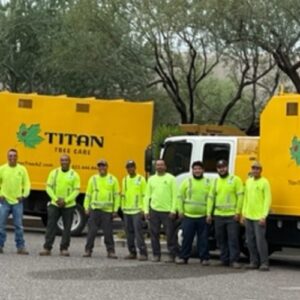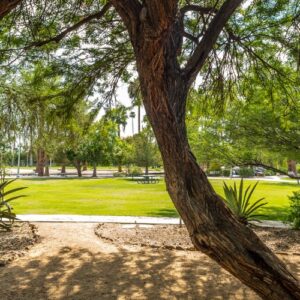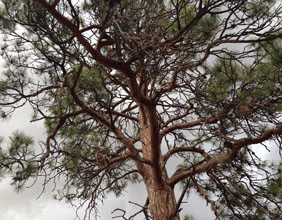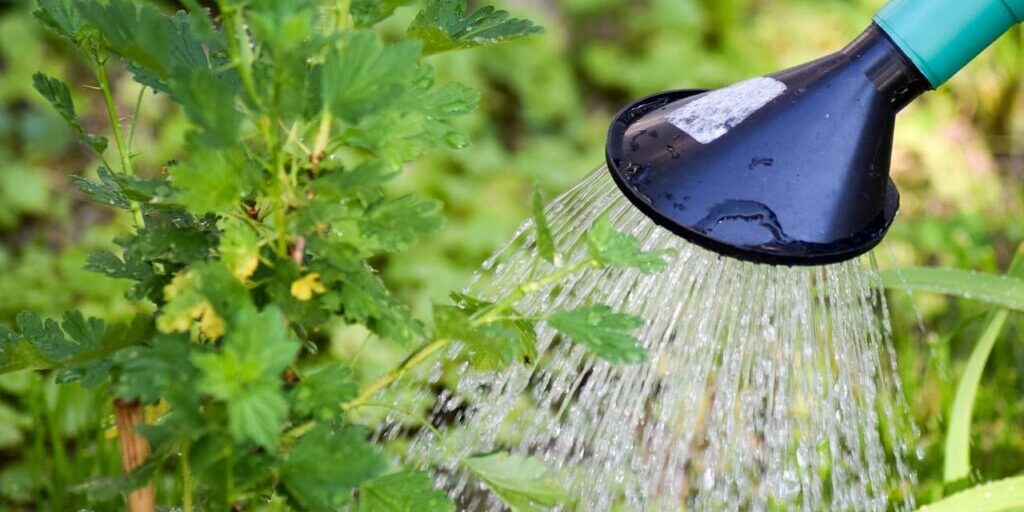
One of the biggest concerns we hear when we mention planting more trees in our area is the amount of water needed. Water is scarce, so why “waste” it on trees?
In our opinion (which is backed up by scientists, forestry workers, arborists, and other members of the green industry), planting a native or  desert-adapted tree is well-worth the water it needs to become established.
desert-adapted tree is well-worth the water it needs to become established.
How much water does a desert tree need, really?
Most native and adapted trees (trees that have adapted to life in the desert) need far less than you may think! In fact, most survive on rainfall alone after the first 2-3 years (although they’ll happily accept an occasional deep watering during the drier summer months).
During the first few years after planting, trees benefit from a long, deep watering at the dripline (where the edge of the tree canopy is). This will help the tree’s roots spread farther and deeper, allowing it to take up more water, steadying it in the ground, and ensuring that it has a better chance of staying upright through monsoons and microbursts.
During the summer months (before the monsoons), or if it has been particularly windy, young trees may need some extra water.
Read our article on how and when to water desert trees in winter!
If a tree is consistently watered after the first few years, it may actually weaken the tree. Many trees are on irrigation systems that are set up to water lawns, smaller shrubs and nearby planting beds. The frequent, shallow watering from these drip or sprinkler irrigation systems loosens the soil, causes roots to stop spreading and keeps them near the surface, and makes it much more likely that the tree will topple over.
Unfortunately, trees in the Phoenix area are more likely to be overwatered than underwatered – and most people aren’t aware of the problem. We encourage you to check your irrigation system to ensure that trees are on a separate zone and are watered more deeply and infrequently than other plants. If in doubt, give us a call – we design, install and maintain in-ground irrigation systems! Also, check your trees for signs of overwatering, such as wilted tips on new shoots or soft tree tissue.
Because of the high salt (mineral) content of our soil, mature trees can benefit from an occasional deep watering to flush salts out of the soil. You can read more about that in our article on salt buildup in desert soil.
Overall, desert trees need very little water to survive, especially compared to trees found in milder climates. Just look at all of the palo verde and mesquite trees thriving in the wild!
Do the benefits outweigh the water usage?
We’ve previously shared some of the amazing benefits of trees and how trees can save you money, but there are some specific things that make trees extra beneficial in a desert environment.
I’m sure you’ve heard about the heat island effect, where temperatures in the greater Phoenix area continue to rise because of the loss of trees and greenery, as well as the increased area covered by pavement and asphalt. Trees cool the air around them, but asphalt traps the daytime heat and releases it at night, causing nighttime temperatures in particular to rise. Instead of the setting sun signaling an end to a sweltering day, the blacktop keeps temperatures high even overnight.
Adding native trees back to the desert environment can cool the air, along with removing pollution, reducing asthma attacks, and more.
“Regreening” or “Combating Desertification” Efforts
There are some efforts to plant trees in deserts around the world. When asked why, these forward thinkers remind us that places that we now see as sandy wastelands, like Egypt, were once green and lush. It’s only because of human activity and construction that many ancient cities eventually became deserts.
There have been several instances where places that were dry and desolate were planted with trees and are now thriving. In an area of Brazil that had been defoliated by cattle overgrazing, a man planted more than 50,000 trees over the course of 40+ years. Now, waterfalls, rivers, and streams have returned. He noted that trees…”are essential for water supplies because trees absorb and retain water in their roots and help to prevent soil erosion.”
There’s a similar story from India and one where 6 men in their 50s worked to take part of north China “back from the desert” after a deadly sandstorm.
Keep in mind, at one point the rivers in Phoenix and Tucson actually flowed with above-ground water year-round.
So, interestingly enough, planting trees may INCREASE the water supply available in Phoenix. Isn’t that an ironic twist? It makes sense, though, as trees not only prevent soil erosion, they release moisture from their leaves through the process of transpiration. This moisture evaporates and eventually becomes clouds – which often produce rainfall.
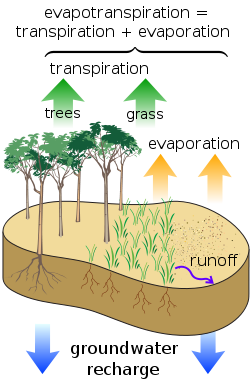
Source: WikiMedia Commons (Website)
What trees need the least amount of water?
Trees that are naturally found in our area generally need the least amount of water when established. Other trees have adjusted to the desert but may need more supplemental water to thrive.
Check out our article on the best shade trees for your Anthem or Greater Phoenix Yard for some specific types of trees to consider.
You can also look at the trees listed on the AMWUA website. They list the water needs for each type of tree. The foothills palo verde, for instance, has very low water needs.
This article from KTAR news lists mesquite trees, palo verde, palo brea, afghan or Aleppo pine, and desert willow as low-water shade trees suitable for our area.
In Summary
We hope you now agree that planting a tree is well worth the (minimal) water that is required to help it thrive. Remember not to water your native, established trees except to flush out the salts (or if we go through a particularly dry season).
If you have any questions about tree planting, tree watering, or tree maintenance, please contact us at Titan Tree Care! We love trees and would love to see you reap the benefits of planting one (or more) trees on your property.
More Articles Like This

Titan Tree Care is a full-service tree care company located in Anthem, AZ and serving all of North Phoenix. We offer a wide range of services to meet your tree care needs, including tree and palm trimming, tree pruning, tree removal, stump grinding, and more. We also offer insect or disease treatments and fertilization services. We are dedicated to providing high-quality, safe, and effective tree care services to our customers and work hard to ensure that your trees are healthy and look their best.





